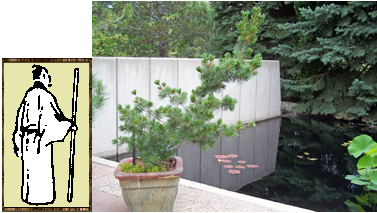
Hexagram Fifty-three—Advancing
Hexagram Fifty-three shows one advancing in small steps. Progress that happens gradually is firm and steady.
The first line, yin, shows an inexperienced person attempting an important job. If there is some error, this person should be encouraged, not criticized. It is similar to a flock of birds flying to shore. The young may have to struggle to keep up, but there is no cause for blame.
The second line, yin, shows a person who rests to take food and drink. This is a necessary step in the journey, just as the birds may land on a rocky cliff to eat.
The third line, yang, warns against neglect of duty. As birds fly to higher ground, so people must take precautions when danger threatens.
The fourth line, yin, advises finding equilibrium. The image is of birds flying into a tree and landing on the level branches.
The fifth line, yang, shows that after a long wait, one attains their wishes. The image is given of birds reaching their destination.
The sixth line, yang, explains that the entire journey is auspicious, and the time thought wasted was actually part of the plan. The analogy is that a bird may lose a feather as it flies over a village, but the people in the village will collect the feather to use in ceremonies.
Hexagram Fifty-three Commentary
This hexagram discusses the importance of firm and steady progress. Everything does not happen all at once, there are steps that lead to a conclusion. Learning to flow with the Dao means learning patience, and learning to pay attention to details.
The subject of the first line, yin, is inexperienced, learning new skills while attempting important work. The best attitude is to encourage the new person, not to find fault if this person's work is not perfect. The metaphor is of birds flying to shore. It says although the younger birds may have trouble keeping up, "there is no cause for blame."
The subject of the second line, yin, rests to have lunch. Although there is more work to do, resting is one step on the journey. The metaphor is of migrating birds who land on a rocky cliff to eat.
The third line, yang, warns of the dangers of neglect of duty. Steady progress means doing what's needed each day. Interruptions come, and that can be dangerous to progress. The solution is to "fly to higher ground" like birds when such danger threatens. After the interruption passes, the birds fly back to continue eating on the ground.
The fourth line, yin, offers another metaphor of birds to demonstrate the equilibrium needed to maintain steady progress over long periods of time. "The image is of birds flying into a tree and landing on the level branches." Level branches imply level headedness.
The fifth line, yang, shows birds reaching their destination. After much work, one will achieve their goals.
The sixth line, yang, describes the feeling of nostalgia after completing a long term project. It's the moment the subject looks back on the months or years and realize it was all perfect. Even something that seemed like a setback, or wasted time when it happened, in retrospect the subject realizes it was all part of the plan. The metaphor is that birds may lose feathers as they fly over a village, but the people will gather the feathers to use in ceremonies. At the time it may have seemed like a feather was lost, but it becomes a permanent part of the ceremony.
To the reader: Most of the hexagrams have at least one line that predicts bad results, but that does NOT mean you are fated to that result. The hexagrams illustrate different attitudes, so study the actions and reactions to learn the attitudes that will lead to better outcomes.
The I Ching teaches you to flow with changes and create positive change from the inside through conscious living. Your future is in your hands. Consult the I Ching for ideas that lead to clear thinking and positive mental attitude. Reading the I Ching helps you take the time to reflect on your attitudes and ideas. Continue asking until you feel positive about your course.

Click here for another hexagram.
A note about this interpretation of the I Ching: Nori Muster wrote this version of the I Ching in 1994 and put it online at Surrealist.org in 2000. It is also available at Amazon:
e-book
paperback
